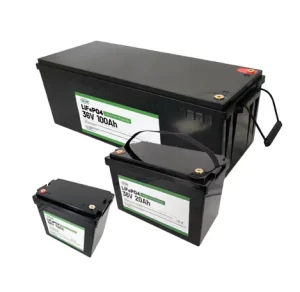Lithium motorcycle batteries have become increasingly popular due to their lightweight design, longer lifespan, and improved performance compared to traditional lead-acid batteries. However, charging a lithium motorcycle battery requires specific knowledge and precautions to ensure optimal performance and longevity. This comprehensive guide will walk you through the steps of charging a lithium motorcycle battery, covering everything from understanding battery types to troubleshooting common issues.
Part 1. Types of lithium motorcycle batteries

Regarding lithium motorcycle batteries, several types are available in the market to suit different needs.
Lithium Iron Phosphate Battery (LiFePO4)
LiFePO4 batteries are known for their safety and longevity. They have a stable chemistry that reduces the risk of thermal runaway, making them ideal for motorcycle applications. These batteries also have a longer lifespan compared to other lithium-ion variants.
Lithium Cobalt Oxide Battery (LiCoO2)
Consumer electronics commonly feature LiCoO2 batteries due to their high energy density. While they offer lightweight and compact designs, they are less suitable for high-discharge applications like motorcycles due to their lower stability and shorter lifespan.
Lithium Manganese Oxide Battery (LiMn2O4)
LiMn2O4 batteries strike a balance between safety, energy density, and cost-effectiveness. People commonly use them in electric vehicles and motorcycles where performance and reliability matter.
Lithium Nickel Cobalt Aluminum Oxide Battery (NCA)
NCA batteries offer high energy density and power output, making them suitable for high-performance motorcycles. However, they are more expensive and less common than other lithium variants.
Lithium Titanate Battery (LTO)
LTO batteries are known for their rapid charging capabilities and extended lifespan. While they may have lower energy density than other lithium-ion batteries, their durability and fast charging make them suitable for demanding motorcycle applications.
Part 2. Preparing for lithium motorcycle battery charging
Inspect Battery Connections
Before charging, visually inspect the battery terminals for any signs of corrosion or damage. Ensure the connections are tight and secure to prevent voltage fluctuations during charging.
Choose the Right Charger
Select a charger specifically designed for lithium batteries and compatible with your motorcycle’s voltage requirements. Using the wrong charger can damage the battery or pose safety hazards.
Check Charging Environment
Charge your battery in a well-ventilated area away from flammable materials. Avoid extreme temperatures, as heat and cold can affect charging efficiency and battery lifespan.
Disconnect Accessories
Disconnect any accessories or devices connected to the battery, such as GPS units or heated gear, to prevent them from drawing power during charging.
Read the Manual
Refer to your motorcycle’s owner’s manual for specific instructions on battery charging. Follow manufacturer recommendations regarding charging voltage, current, and duration to avoid overcharging or undercharging.
Part 3. Selecting the best way to charge your lithium motorcycle battery
Here are some key considerations to help you choose the correct charging method:
Dedicated Lithium Battery Charger
These chargers are equipped with advanced charging algorithms tailored to lithium chemistry, ensuring safe and efficient charging without overcharging or damaging the battery.
Fast Chargers
While fast chargers can recharge your battery quickly, they may subject it to higher temperatures and stress, potentially reducing lifespan. Unless you require rapid charging for specific situations, such as emergencies or racing events, opt for standard charging methods to preserve battery health.
Balancing Chargers for Multiple Cell Batteries
Consider using a balancing charger if your lithium motorcycle battery has multiple cells connected in series. Balancing chargers help equalize the voltage across individual cells, preventing overcharging of any single cell and ensuring uniform charging for optimal performance and longevity.
Solar Chargers for On-the-Go Charging
Solar chargers offer a convenient way to recharge lithium motorcycle batteries using renewable energy sources for riders who frequently embark on long journeys or off-grid adventures. Choose a solar charger with sufficient output power to meet your charging needs and ensure compatibility with lithium batteries.
Smart Chargers
Invest in a smart charger equipped with automatic voltage detection capabilities. These chargers can identify the battery’s voltage and adjust the charging parameters accordingly, eliminating the risk of overcharging or undercharging and optimizing charging efficiency.
Part 4. Charging a lithium motorcycle battery: step-by-btep guide
Prepare Your Workspace
Choose a well-ventilated area to charge your battery, away from flammable materials and direct sunlight. Ensure that the charging environment is clean and free from obstructions.
Gather Necessary Equipment
Gather your lithium battery charger that is compatible with your motorcycle’s battery specifications. Check the charger’s cables and connectors for any signs of damage before proceeding.
Inspect the Battery
Before charging, visually inspect the battery for any physical damage or leaks. Ensure that the terminals are clean and free from corrosion. If you notice any abnormalities, consult a professional before proceeding with charging.
Connect the Charger
Connect the charger cables to the battery terminals, observing polarity (positive to positive, negative to negative). Ensure the connections are tight and secure to prevent arcing or sparks during charging.
Select Charging Mode
Select the appropriate charging mode for lithium batteries depending on your charger model. Follow the manufacturer’s instructions to set your battery’s correct voltage and current settings.
Initiate Charging
Start the charging process by turning on the charger and allowing it to supply power to the battery. Monitor the charging progress closely and check for abnormalities such as excessive heat or unusual noises.
Monitor Charging Status
Monitor the charger’s indicators or display to monitor the charging status. Most chargers will indicate when the battery reaches full charge or encounter any issues during the charging process.
Disconnect Charger
Once it reaches full charge, disconnect the charger from the battery terminals to prevent overcharging. Follow the manufacturer’s recommendations regarding charging duration to avoid overcharging or undercharging.
Perform Post-Charging Checks
After charging, inspect the battery and connections again for any signs of overheating or damage. Ensure that the battery terminals are clean and free from corrosion.
Store Charger Safely
Store your charger in a safe and dry place when not in use, away from moisture and extreme temperatures. Proper storage helps prolong the lifespan of your charger and ensures its reliability for future use.
Part 5. Conclusion
Correctly charging a lithium motorcycle battery is essential for maintaining its performance, maximizing lifespan, and ensuring a reliable power source for your rides. Following the step-by-step guide in this article and implementing proper maintenance and troubleshooting techniques, you can enjoy the benefits of a fully charged and well-maintained lithium motorcycle battery throughout your journeys.
Part 6. FAQs
-
Are lithium batteries better for motorcycles?
Lithium batteries are often considered better for motorcycles due to their lightweight, higher energy density, and longer lifespan than traditional lead-acid batteries. -
Can I use a lithium battery on my motorcycle?
Yes, you can use a lithium battery in your motorcycle, provided it is compatible with your motorcycle’s specifications and electrical system. However, ensuring that the battery’s voltage and dimensions match your motorcycle’s requirements is essential. -
Do you need a special charger for lithium motorcycle batteries?
Yes, it’s recommended to use a special charger explicitly designed for lithium motorcycle batteries. These chargers are equipped with algorithms tailored to lithium chemistry, ensuring safe and efficient charging without overcharging or damaging the battery. -
How long do lithium motorcycle batteries last?
On average, lithium motorcycle batteries can last between 3 and 5 years, depending on factors such as usage patterns, maintenance, and environmental conditions. Proper care and maintenance can prolong the lifespan of the battery. -
How long does it take to charge a lithium motorcycle battery?
The charging time for a lithium motorcycle battery depends on various factors, such as the battery’s capacity, the charger’s output, and the battery’s current charge level. Charging a lithium motorcycle battery takes a few hours, but charging times may vary.
Related Tags:
More Articles

Overview of Deep Cycle Lithium Battery
In this article, we explore the life, voltage, capacity, and charging considerations of deep cycle lithium batteries.
How Long do Lithium Batteries Last?
How long do lithium batteries last? we will explore the factors that influence the lifespan of lithium batteries and provide insights into their longevity.
How to Choose the Best LiFePO4 Battery?
Choose LiFePO4 batteries for superior performance, safety, and versatility in EVs, UPS, and backup power. This guide helps you make informed decisions.
Get 12v Lithium Car Battery As a Power Source for the Ride
Make the right choice for your vehicle's battery needs by installing a 12 volt lithium car battery. You will enjoy maintenance-free longevity with this change.
Everything About A Small Lithium Ion Battery
Discover the features, uses & future potential of a small lithium ion battery. A compact and tiny powerhouse ideal for smartphones, wearables, drones & more.





